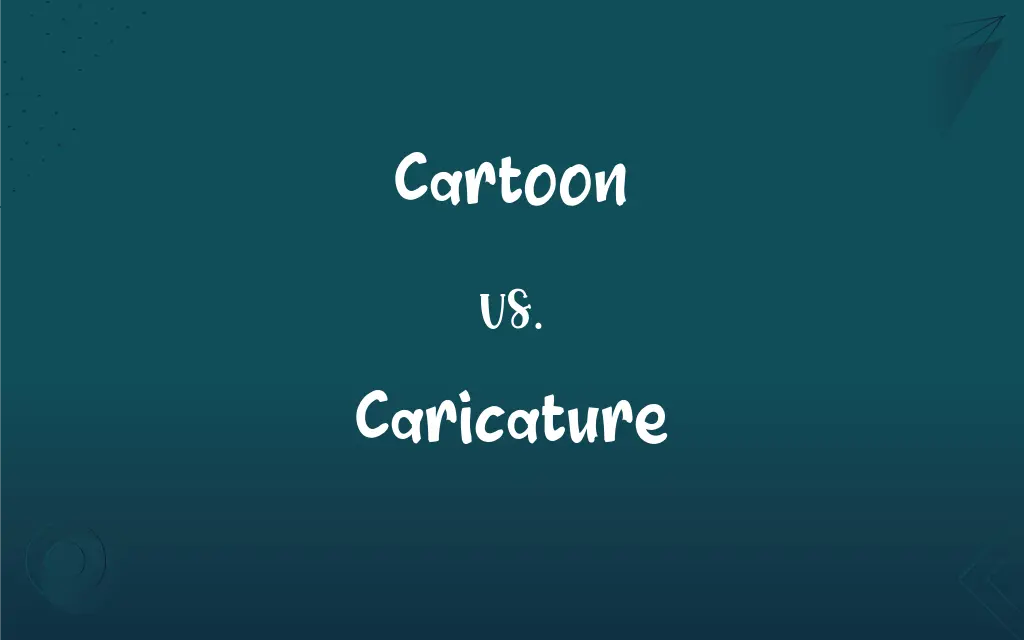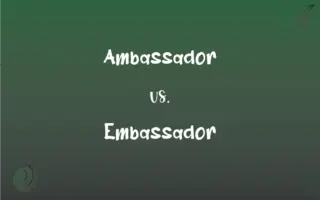Cartoon vs. Caricature: What's the Difference?
Edited by Harlon Moss || By Janet White || Published on December 4, 2023
Cartoon is simplified, exaggerated artwork for humor or satire. Caricature is exaggerated portrayal of a person's features for comic effect.

Key Differences
Cartoons are artistic forms, often simplified and stylized, used primarily for entertainment and satire. Caricatures, on the other hand, are a subset of cartoons focused specifically on exaggerating physical features of individuals to create a humorous or critical effect.
While cartoons can encompass a wide range of subjects, including non-human characters, caricatures are exclusively focused on humans, highlighting and often distorting their unique physical characteristics for heightened impact.
Cartoons often tell a story or convey a message using visual humor, utilizing a variety of artistic styles. Caricatures, however, concentrate on visual exaggeration and distortion, emphasizing certain traits to convey a deeper, often critical, message about the subject.
The purpose of cartoons can vary, ranging from simple entertainment to sharp political commentary. In contrast, caricatures are primarily used to mock or satirize their subjects, emphasizing their flaws or notable features in a humorous manner.
Both cartoons and caricatures are forms of visual art, cartoons have a broader application in media including animation, comics, and illustrations. While, caricatures are more niche, mostly found in editorial cartoons or as standalone pieces in print or digital media.
ADVERTISEMENT
Comparison Chart
Focus
Broad, can include various subjects.
Specifically focuses on individuals.
Style
Varies, from realistic to highly stylized.
Exaggeration of physical features.
Purpose
Entertainment, storytelling, satire.
Humor, social or political criticism.
Medium
Comics, animation, print.
Editorial cartoons, portraits.
Subject Matter
Anything from daily life to fantasy.
Primarily human figures.
ADVERTISEMENT
Cartoon and Caricature Definitions
Cartoon
A preliminary sketch for a larger work of art.
The artist's cartoon for the mural outlined the basic design.
Caricature
A depiction in which certain features are exaggerated to create a grotesque or comic effect.
His caricature of the celebrity emphasized his distinctive nose.
Cartoon
A comic strip or single-panel drawing, often humorous.
His favorite cartoon in the magazine always featured talking animals.
Caricature
A drawing or painting that distorts the physical features of a person for humorous effect.
The caricature on the cover of the magazine made everyone laugh.
Cartoon
A simplified or exaggerated visual depiction in art, used for humor or satire.
The cartoon in the newspaper cleverly satirized current political events.
Caricature
A representation of someone that exaggerates their characteristics for satirical purposes.
The political caricature in the newspaper highlighted the politician's known traits.
Cartoon
Animated films or series, especially those intended for children.
Saturday mornings were filled with watching cartoons.
Caricature
A portrayal in literature or drama that exaggerates certain traits for comic effect.
The play's caricature of a pompous businessman was both funny and insightful.
Cartoon
A non-realistic or semi-realistic artistic style used in illustration and animation.
The cartoon style of the video game made it appealing to younger players.
Caricature
An exaggerated portrayal of someone's physical features or personality traits for comic effect.
The caricature artist at the fair captured her big smile and curly hair hilariously.
Cartoon
A drawing depicting a humorous situation, often accompanied by a caption.
Caricature
A representation, especially pictorial or literary, in which the subject's distinctive features or peculiarities are deliberately exaggerated to produce a comic or grotesque effect.
Caricature
The art of creating such representations.
FAQs
Do cartoons always involve animation?
No, cartoons can be static images like comic strips or animated films and series.
What defines a caricature?
A caricature is an exaggerated depiction of a person's physical features or personality traits, typically for humorous or satirical purposes.
How old is the art of cartooning?
Cartooning dates back centuries, with early examples found in ancient cultures.
Can caricatures be offensive?
Yes, caricatures can be seen as offensive if they exaggerate features in a disrespectful or harmful way.
Are cartoons always funny?
No, cartoons can range from humorous to serious, serving various purposes like entertainment, satire, or social commentary.
Can cartoons be educational?
Yes, cartoons can be used for educational purposes, especially in children's media.
What's the main purpose of a caricature?
The main purpose is to entertain or make a satirical point by exaggerating someone's physical or personality traits.
What is a cartoon?
A cartoon is a simplified or exaggerated visual artwork used for humor, satire, or storytelling.
Is it hard to make a caricature?
It can be challenging as it requires an understanding of anatomy and the skill to exaggerate features while maintaining recognizability.
Do caricatures require artistic skill?
Yes, creating a caricature requires artistic skill, particularly in understanding and exaggerating features.
Are cartoons a modern invention?
While cartoons have evolved, the concept of creating humorous or satirical images is not modern and has historical precedents.
Are caricatures only drawn?
While traditionally drawn, caricatures can also be created digitally or sculpted.
Are caricatures always about real people?
Mostly, yes. They typically depict real individuals, especially public figures.
Can cartoons be for adults?
Absolutely, many cartoons are created with adult audiences in mind.
What mediums are used for cartoons?
Cartoons can be created in various mediums, including pencil, ink, digital tools, or animation software.
Do cartoons always have dialogue?
No, some cartoons are purely visual with no dialogue.
Can anyone create a caricature?
With practice, anyone can learn to create caricatures, though it requires skill in art and observation.
Are cartoons considered a serious art form?
Yes, cartoons are recognized as a legitimate and influential form of art and communication.
Can caricatures be part of political commentary?
Yes, caricatures are often used in political commentary to satirize politicians and public figures.
Can caricatures be flattering?
While typically humorous or critical, caricatures can be created in a flattering manner, emphasizing positive traits.
About Author
Written by
Janet WhiteJanet White has been an esteemed writer and blogger for Difference Wiki. Holding a Master's degree in Science and Medical Journalism from the prestigious Boston University, she has consistently demonstrated her expertise and passion for her field. When she's not immersed in her work, Janet relishes her time exercising, delving into a good book, and cherishing moments with friends and family.
Edited by
Harlon MossHarlon is a seasoned quality moderator and accomplished content writer for Difference Wiki. An alumnus of the prestigious University of California, he earned his degree in Computer Science. Leveraging his academic background, Harlon brings a meticulous and informed perspective to his work, ensuring content accuracy and excellence.






































































